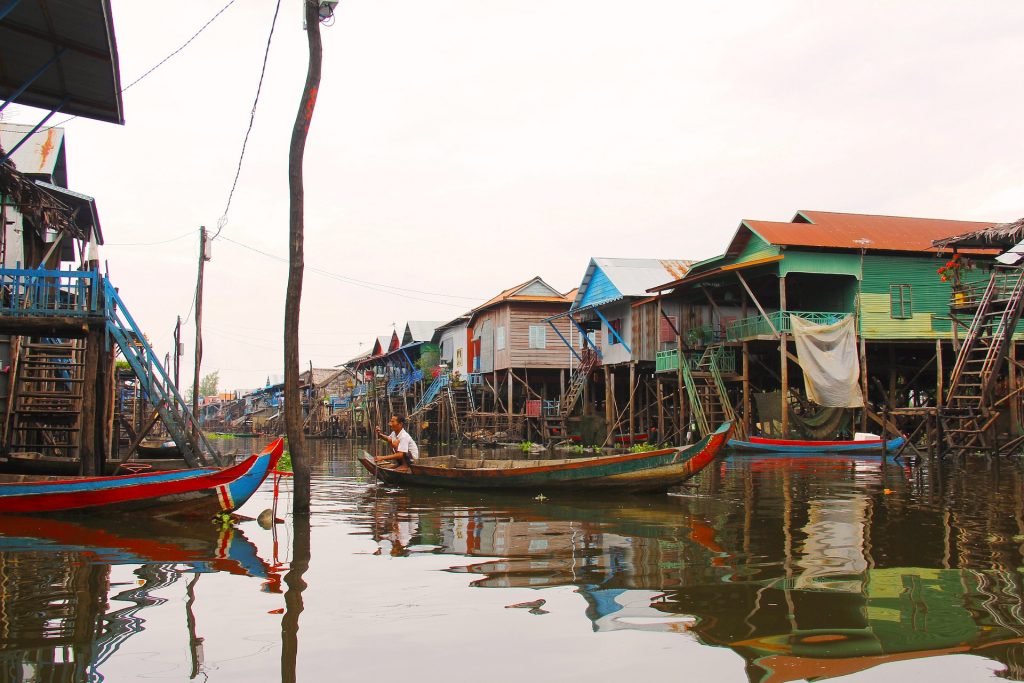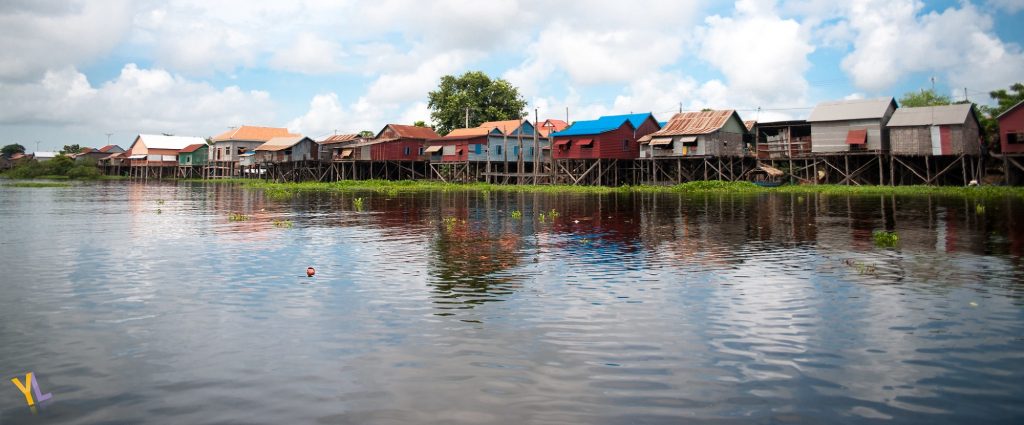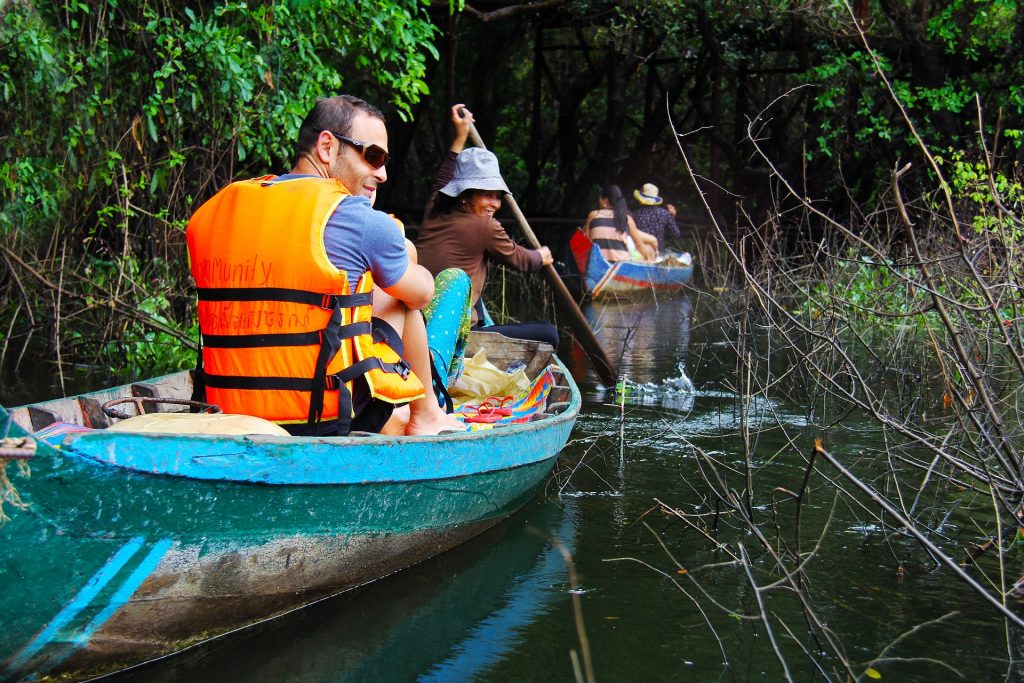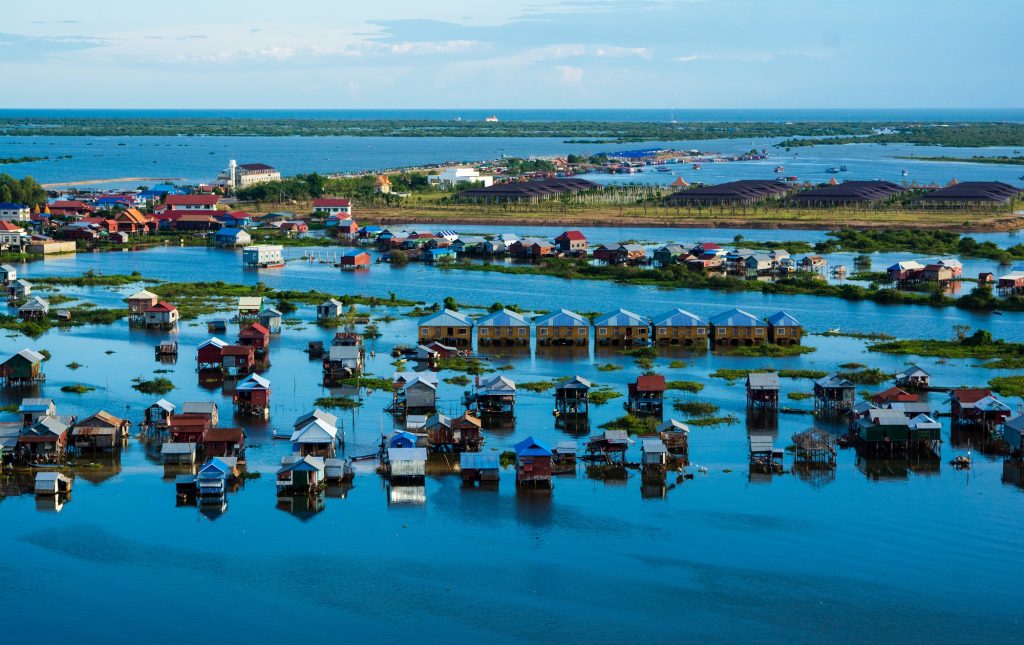Heard of the floating villages in Siem Reap and wondering if they’re worth visiting? You’ve come to the right place. In this article, we’ll lay out the essential primers for a successful visit to the Siem Reap floating village. This includes the top 3 floating villages we recommend and useful local tips. So, stick around to the end!
What are the floating villages in Siem Reap like?



Imagine waking up and getting on a boat to go about your day. That could be going to work (as fishermen), going to school or the markets. Life at the Siem Reap floating villages functions on the Tonle Sap Lake. The lake is the most important lake for the livelihood of locals and biodiversity in Cambodia.
The villagers have also adapted to the unique ebb and flow of the Tonle Sap Lake through the seasons. While the houses don’t float per se—they’re actually built on tall wooden stilts above the water—the main mode of travel around the villages is by boat. Also, during the dry season, villagers build temporary homes closer to the water that’s mostly dried up.
Which Siem Reap floating village is the best one to visit?
Our top choice: Kompong Khleang



If you want to see a Siem Reap floating village in all its authenticity, then we highly recommend choosing Kompong Khleang. Here are just a couple of reasons why it’s worth going there:
1). The money goes directly to the locals. Everything from the entrance fee and tourism tax, to the food and snacks you buy there, flows back to the local community. Many people in floating villages live in poverty, so it’s crucial that the growing tourism actually supports them.
2). It’s not a tourist trap. Located about 50 km from Siem Reap, Kompong Khleang is about a one-hour drive away by car. It’s not crowded with tourists at all. This means scams are far fewer and you get to truly see the life of villagers.
3). The view is beautiful. Be sure to take a boat ride out to catch the gorgeous sunset on the Tonle Sap Lake. Also, largely untouched by outsiders, the village doesn’t face problems such as overflowing trash that tends to happen at touristy spots.
The best part is, getting there doesn’t have to be a hassle. You can take a day trip with a Siem Reap local that includes a hotel pick-up and drive there by private car (which is much quicker than other transport options). With your guide, you’ll also be able to meaningfully connect with the villagers and deeply learn about their way of life.
Entrance fee: 21$/person (1 person); 20$/person (more than 1 person)
Other Floating Villages in Siem Reap Worth Checking Out
If you’d like to explore other options, then these two villages are also good choices:
Kompong Phluk



Closer to Siem Reap city than Kompong Khleang, Kompong Phluk is only about 16 km away. The highlight at the floating village is the mangrove forest that you can take a paddleboat through.
It’s the largest floating village in the area. Scams are also not as rampant as Chong Kneas (more details below). If you only want a half-day trip to fit in your itinerary, then Kompong Phluk should be a good fit.
The only potential downside is that the boat ticket service is not run by the villagers, so it’s hard to know how the money is flowing back into the local community. However, many travelers to Kompong Phluk report pleasant experiences.
Entrance fee: 20$/person for the boat ticket. If you’d like to take the paddleboat into the mangrove forest, it’s an additional 5$ ticket. But trust us, the extra 5$ is worth it.
Prek Toal Floating Village



For nature lovers, specifically bird lovers, perk up. The Prek Toal Floating Village is home to the Prek Toal Bird Sanctuary that sees an incredible flock of exotic birds during the migrating season.
It’s one of the three main biospheres of the Tonle Sap Lake, with beautiful and interesting bird species such as the slim adjutant storks, the chubbier milky stork, and the grey pelican. It’s astounding to see them in incredible numbers.
The peak season to catch the birds is between December and early February. You can also still enjoy the Prek Toal Floating Village for a peek into the locals’ lives.
Chong Kneas: To visit or not to visit?
The first floating village you’ll hear about, a quick check on TripAdvisor will likely make up your mind. Though the closest to Siem Reap city and seemingly the most convenient, its near distance for tourists has also spawned numerous scams that are simply too much of a hassle to deal with.
Begging and shows (like children holding water snakes) are also widespread, draining much of the authentic feeling that you’re likely looking for in your visit. So, if you have time to spare, we recommend heading a bit further out to the other floating villages for a more worthwhile experience.
When’s the best time to visit the Siem Reap floating villages?



If you want to see the village ‘float’ (when the water floods up to the bottom of the houses) then the best time to go is during the rainy season between June and November. However, the dry season is also a good time to visit. You can see the interesting wooden stilts that hold the houses up and walk in the dried up parts of the village.
The main period we recommend to avoid is between March and May when the summer is at its peak and most of the water in the lake is dried up.
What to keep in mind when visiting floating villages?
If you’re planning to visit the floating villages by yourself, then you definitely have to go prepared. This means being familiar with the scams. Common ones to watch out for are:
1). Overpriced boat tickets. You either pay more than usual upfront or you keep getting asked to pay more as you go.
2). Buying school materials to donate to children. This is often reported by visitors to Chong Kneas. The basic maneuver involves your ‘boat guide’ taking you to visit a school and supplies shop. There you’ll be asked to buy overpriced items to donate to the children. While the poor condition of the children might make you want to help, the unfortunate truth is that it doesn’t. The money will only be split among the operators and the supplies you bought going back to the shop.
3). Tuk-tuk drivers who are in on the game. Beware of asking recommendations from a tuk-tuk driver. Chances are they could be benefiting from the scam too. After taking you to the scammers, they’d show an unwillingness to change directions. It’s better to ask from your hotel reception, or read guides like this one 😉
Another option is to go on a day tour with reputable companies, which is what many travelers do. At TakeMeTour, we also have a day trip to Kompong Khleang with a local who deeply knows the area. On the trip, you can also visit the traditional homes of locals, see how rice is harvested and palm sugar is handmade.
Done right, visiting the floating villages in Siem Reap is an eye-opening experience



We hope you found this brief guide helpful! If you have any questions or spot inaccuracies that differ from your experience, let us know down in the comments. We’d be happy to hear from you!
If you’re wondering what to do in Siem Reap after checking Angkor Wat off your bucket list, here are 15 things to do beyond Angkor Wat that’ll make for a wonderful trip!
